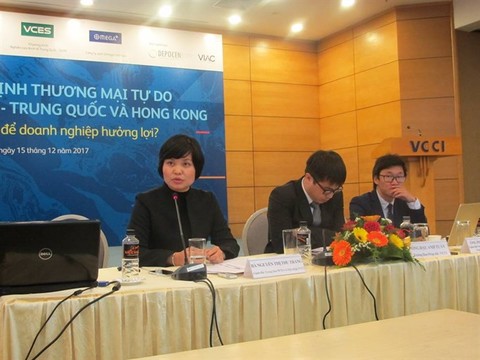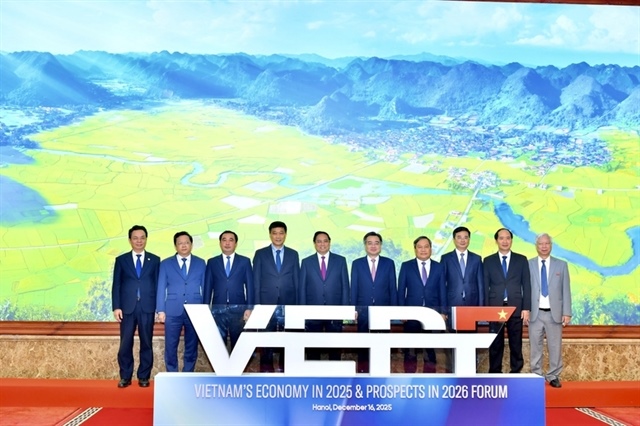VN businesses face risks from Hong Kong, China FTAs
VN businesses face risks from Hong Kong, China FTAs
Following the recently signed ASEAN-Hong Kong Free Trade Agreement (AHKFTA) and the 2016 revised ASEAN–China Free Trade Area (ACFTA), Vietnamese enterprises have another great opportunity to increase their profitability in the Chinese market, achieving this potential also poses a major challenge.

At a conference yesterday in Ha Noi, Nguyen Thi Thu Trang, Director of the Vietnam Chamber of Commerce and Industry (VCCI) Centre for WTO and Economic Integration, noted the key benefits of the upgraded ACFTA, the AHKFTA, the Vietnam-China Border Trade Agreement and other bilateral agreements.
She drew a picture of Viet Nam’s current trade situation as the country now takes part in 16 FTAs, and an overview of bilateral commodity trade commitments between Viet Nam and China.
Trang emphasised that these agreements would bring much opportunity for tariff reduction or investment opportunities, but merely create more favourable conditions for Vietnamese producers to increase exports to Hong Kong before entering the Chinese market.
However, she warned that these advantages come with harsh conditions and requirements on products’ origin, goods rotation and other investment issues.
According to Trang, in order to benefit from these FTAs, Vietnamese enterprises must learn to grasp any upcoming opportunities and, in order to compete with imported goods from China or Hong Kong, find their own competitive advantage in terms of price, quality, or originality.
Pham Sy Thanh, Director of the Vietnam Centre for Economics and Policy Research (VEPR)’s China Economic Research Programme (VCES), spoke at the same conference on the trade strategy situation between China and Southeast Asia. He focused on the former’s One Belt One Road Initiative (OBOR).
According to Thanh China is an important trade partner for all countries, whose influence is rising in the era of e-commerce, mobile payments and startups. Therefore, local firms need more technical, practical and modern approaches to do business with China.
He considered the most problematic issue now to be for domestic exporters to prove their products’ origin by obtaining Certificate of Origins, in dealing with China or any other trade partners.
Bui Kim Thuy, Deputy Head of the Department of Origin, Department of Export and Import under the Ministry of Industry and Trade (MoIT), agreed with Thanh, explaining that Vietnamese enterprises need to establish a legal basis to prove the goods’ nationality before they can enjoy FTA tariff preferences.
She also raised the question of finding technical solutions to make use of the new rules of origin under the ACFTA upgrade and for businesses to gain benefits from the AHKFTA.
These FTAs are full of potential, according to Thuy, as the AHKFTA, signed on November 21, 2017, allows smoother trade flows between ASEAN countries in general and Viet Nam in particular with Hong Kong, and the revised ACFTA Protocol of 2016 enhances trade capacity between ASEAN countries and China.
Nevertheless, she said the MoIT was very concerned with helping businesses get the ideal tariff preferences from these FTAs and stimulating their search for raw materials and incentives for productivity.
As Viet Nam has yet to fully build up or effectively use trade barriers to protect the domestic market in accordance with WTO rules, these FTAs may have negative impacts on the country’s economic growth and products’ competitiveness.
If left unchanged, some Vietnamese manufacturing industries would soon be facing the risk of downsizing or closing down, as they fail to compete with Chinese goods which may soon be taking over the domestic market, Thuy warned.
Speaking at the conference, Bui Van Thanh, representative from the International Arbitration Center of Vietnam, noted that when Vietnamese firms sign joint business contracts with China, they must learn to prevent legal risks and understand that there are feasible and effective resolution methods for commercial contracts disputes.
Statistics from the General Department of Vietnam Customs were cited at the conference. Notably, total 2016 bilateral trade turnover between Viet Nam and China reached US$71.9 billion, up 7.9 per cent from 2015.
At the end of 2016, Viet Nam’s exports to China were $21.97 billion, up 28.4 per cent; having imported $49.93 billion worth of goods and services from China. In total, the country experienced a trade deficit of $27.96 billion, a 13.67 per cent decrease from 2015’s number.
China remains Viet Nam’s leading trade partner, import market with the largest trade deficit and second-largest export market after the US.
Yesterday’s conference was jointly organised by the VCCI’s Centre for WTO and Economic Integration, the VEPR’s VCES, the Development and Policies Research Center, and the Omega Vietnam Book Company.


















